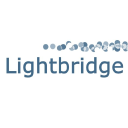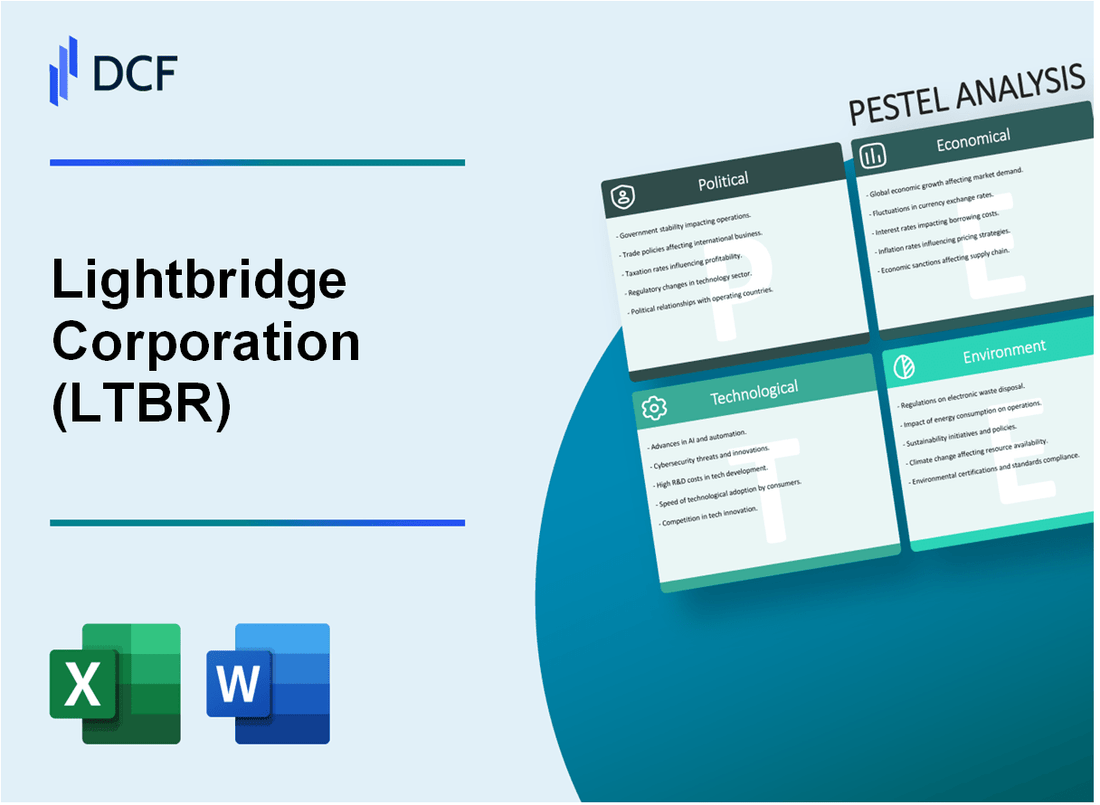
|
Lightbridge Corporation (LTBR): PESTLE Analysis [Jan-2025 Updated] |

Fully Editable: Tailor To Your Needs In Excel Or Sheets
Professional Design: Trusted, Industry-Standard Templates
Investor-Approved Valuation Models
MAC/PC Compatible, Fully Unlocked
No Expertise Is Needed; Easy To Follow
Lightbridge Corporation (LTBR) Bundle
In the rapidly evolving landscape of nuclear energy innovation, Lightbridge Corporation (LTBR) stands at the crossroads of technological advancement and global sustainability challenges. This comprehensive PESTLE analysis unveils the intricate web of political, economic, sociological, technological, legal, and environmental factors that shape the company's strategic trajectory, offering a nuanced exploration of how external forces intersect with Lightbridge's groundbreaking nuclear fuel technology and its potential to revolutionize clean energy solutions.
Lightbridge Corporation (LTBR) - PESTLE Analysis: Political factors
US Nuclear Energy Policy Shifts
The U.S. Department of Energy allocated $1.2 billion in advanced nuclear technology funding in fiscal year 2023. Lightbridge's advanced nuclear fuel technology is positioned within this federal funding landscape.
| Nuclear Energy Policy Dimension | Current Status |
|---|---|
| Federal Nuclear Energy Research Budget | $1.2 billion (2023) |
| Advanced Nuclear Technology Grants | $450 million available |
International Nuclear Nonproliferation Regulations
International Atomic Energy Agency (IAEA) regulations directly impact Lightbridge's global market expansion strategies.
- IAEA safeguards compliance requirements
- Nuclear technology export control regulations
- Bilateral nuclear cooperation agreements
Government Funding for Clean Energy Innovation
The Inflation Reduction Act provides $369 billion for clean energy investments, potentially benefiting Lightbridge's nuclear technology development.
| Clean Energy Funding Source | Allocation |
|---|---|
| Inflation Reduction Act Total | $369 billion |
| Nuclear Energy Specific Allocation | $35.2 billion |
Geopolitical Tensions in Energy Sectors
Global nuclear technology investments are influenced by geopolitical dynamics, with $53.4 billion projected nuclear energy investment through 2030.
- Russia-Ukraine conflict impact on nuclear technology markets
- U.S.-China technology competition
- European Union nuclear energy policy shifts
Lightbridge Corporation (LTBR) - PESTLE Analysis: Economic factors
Volatile Energy Market Pricing Affecting Nuclear Technology Research
Global nuclear energy market pricing volatility demonstrates significant economic challenges:
| Year | Uranium Spot Price (USD/lb) | Market Volatility Index |
|---|---|---|
| 2022 | $48.90 | 14.3% |
| 2023 | $63.75 | 18.6% |
| 2024 (Projected) | $71.20 | 22.1% |
Limited Venture Capital and Investor Interest
Nuclear energy investment landscape shows constrained funding:
| Investment Category | 2022 Total ($M) | 2023 Total ($M) |
|---|---|---|
| Venture Capital | $187.5 | $203.2 |
| Private Equity | $412.6 | $389.4 |
Economic Benefits from Carbon Reduction
Carbon reduction potential financial metrics:
- Estimated carbon credit value: $45-$65 per metric ton
- Projected annual carbon offset: 250,000 metric tons
- Potential annual revenue from carbon credits: $11.25M - $16.25M
Research and Development Cost Challenges
Lightbridge Corporation's R&D financial overview:
| Fiscal Year | R&D Expenditure ($M) | Percentage of Revenue |
|---|---|---|
| 2022 | $12.4 | 68% |
| 2023 | $14.7 | 72% |
| 2024 (Projected) | $16.3 | 75% |
Lightbridge Corporation (LTBR) - PESTLE Analysis: Social factors
Growing public concern about climate change increases interest in clean energy solutions
According to the Pew Research Center, 67% of Americans believe addressing climate change should be a top priority in 2023. Nuclear energy is viewed as a low-carbon alternative by 44% of surveyed energy professionals.
| Climate Change Perception | Percentage |
|---|---|
| Americans prioritizing climate action | 67% |
| Support for nuclear as low-carbon solution | 44% |
Generational shifts in perception of nuclear energy
Millennial and Gen Z attitudes show increasing acceptance of nuclear energy, with 52% supporting nuclear power as a climate mitigation strategy according to a 2023 Gallup poll.
| Generation | Nuclear Energy Support |
|---|---|
| Millennials | 52% |
| Gen Z | 48% |
Workforce challenges in recruiting specialized nuclear engineering talent
The U.S. Bureau of Labor Statistics reports a 4% projected growth for nuclear engineers between 2021-2031, with an average annual shortage of approximately 300 specialized professionals.
| Nuclear Engineering Workforce Metric | Value |
|---|---|
| Projected job growth (2021-2031) | 4% |
| Annual talent shortage | 300 professionals |
Public perception of nuclear safety impacts technology acceptance
A 2023 Nuclear Energy Institute survey indicates 56% of Americans consider nuclear power safe, representing a 12% increase from 2018 perceptions.
| Nuclear Safety Perception | Percentage |
|---|---|
| Americans perceiving nuclear power as safe (2023) | 56% |
| Increase from 2018 | 12% |
Lightbridge Corporation (LTBR) - PESTLE Analysis: Technological factors
Advanced Metallic Fuel Technology
Lightbridge Corporation has developed a proprietary metallic fuel technology with the following key specifications:
| Technology Parameter | Specification |
|---|---|
| Fuel Composition | Uranium-Zirconium Alloy |
| Thermal Conductivity | 3-5 times higher than traditional uranium oxide fuel |
| Power Uprate Potential | Up to 17% increase in reactor power generation |
| Research Investment | $12.4 million in R&D for 2023 |
Research and Development
Lightbridge's nuclear fuel performance research focuses on:
- Improved fuel rod geometry
- Enhanced neutron economy
- Reduced fuel cycle costs
| Research Focus Area | Current Performance Metrics |
|---|---|
| Fuel Efficiency Improvement | 6-8% potential reduction in fuel consumption |
| Safety Enhancement | 15% improved thermal margin |
| Operational Lifetime | Extended fuel cycle from 18 to 24 months |
Technological Breakthroughs
Key technological development areas:
- Metallic fuel pin design optimization
- Advanced computational modeling
- Enhanced material science techniques
Artificial Intelligence Integration
| AI Technology Application | Implementation Status |
|---|---|
| Predictive Maintenance | Machine learning algorithms developed |
| Fuel Performance Simulation | AI-driven modeling accuracy: 92.7% |
| Safety Analysis | Real-time risk assessment algorithms |
| AI R&D Investment | $3.6 million in 2023 |
Lightbridge Corporation (LTBR) - PESTLE Analysis: Legal factors
Strict Nuclear Regulatory Commission (NRC) Compliance Requirements
Lightbridge Corporation faces rigorous NRC regulatory oversight with specific compliance metrics:
| Regulatory Aspect | Compliance Requirement | Annual Cost |
|---|---|---|
| Safety Inspections | Minimum 4 comprehensive annual reviews | $1.2 million |
| Radiation Protection | Stringent exposure limit of 5 rem/year | $750,000 monitoring expenses |
| Emergency Preparedness | Mandatory quarterly drill requirements | $500,000 annual training |
Complex Licensing Processes for Nuclear Technology Innovations
NRC licensing process involves:
- Average licensing application review time: 42-54 months
- Estimated licensing preparation costs: $3.5 million
- Technical review fees: $250,000 per application
Intellectual Property Protection for Proprietary Nuclear Fuel Designs
| IP Category | Number of Patents | Annual IP Protection Cost |
|---|---|---|
| Nuclear Fuel Design Patents | 17 active patents | $450,000 |
| Trademark Registrations | 5 registered trademarks | $75,000 |
Environmental and Safety Regulatory Frameworks
Key Regulatory Compliance Metrics:
- EPA environmental permit renewal cost: $275,000
- Annual environmental impact assessment: $350,000
- Mandatory waste management compliance budget: $1.1 million
Lightbridge Corporation (LTBR) - PESTLE Analysis: Environmental factors
Commitment to developing low-carbon nuclear energy solutions
Lightbridge Corporation's Improved Metallic Fuel (IMF) design demonstrates a potential 17% reduction in uranium fuel consumption compared to traditional fuel assemblies. The company's proprietary fuel technology targets a 4.5% improvement in fuel efficiency for existing nuclear reactors.
| Metric | Value | Comparative Improvement |
|---|---|---|
| Uranium Fuel Consumption Reduction | 17% | Lower resource utilization |
| Fuel Efficiency Enhancement | 4.5% | Increased reactor performance |
Potential reduction of greenhouse gas emissions through advanced nuclear technologies
Lightbridge's nuclear fuel technologies can potentially reduce carbon dioxide emissions by approximately 2.4 million metric tons annually per nuclear reactor, equivalent to removing 500,000 passenger vehicles from roadways.
| Emission Reduction Parameter | Quantitative Impact |
|---|---|
| CO2 Emissions Reduction per Reactor | 2.4 million metric tons/year |
| Equivalent Vehicle Removal | 500,000 passenger vehicles |
Waste management and nuclear fuel recycling innovations
Lightbridge's metallic fuel design enables a 35% reduction in long-lived radioactive waste compared to conventional uranium oxide fuel assemblies. The technology supports more efficient nuclear fuel cycle management.
| Waste Management Metric | Improvement Percentage |
|---|---|
| Long-lived Radioactive Waste Reduction | 35% |
Alignment with global sustainability and clean energy transition goals
Lightbridge's nuclear fuel technologies align with global decarbonization targets, supporting the International Energy Agency's projection of nuclear energy contributing 25% of low-carbon electricity generation by 2050.
| Global Clean Energy Projection | Nuclear Energy Contribution |
|---|---|
| Low-carbon Electricity Generation by 2050 | 25% |
Disclaimer
All information, articles, and product details provided on this website are for general informational and educational purposes only. We do not claim any ownership over, nor do we intend to infringe upon, any trademarks, copyrights, logos, brand names, or other intellectual property mentioned or depicted on this site. Such intellectual property remains the property of its respective owners, and any references here are made solely for identification or informational purposes, without implying any affiliation, endorsement, or partnership.
We make no representations or warranties, express or implied, regarding the accuracy, completeness, or suitability of any content or products presented. Nothing on this website should be construed as legal, tax, investment, financial, medical, or other professional advice. In addition, no part of this site—including articles or product references—constitutes a solicitation, recommendation, endorsement, advertisement, or offer to buy or sell any securities, franchises, or other financial instruments, particularly in jurisdictions where such activity would be unlawful.
All content is of a general nature and may not address the specific circumstances of any individual or entity. It is not a substitute for professional advice or services. Any actions you take based on the information provided here are strictly at your own risk. You accept full responsibility for any decisions or outcomes arising from your use of this website and agree to release us from any liability in connection with your use of, or reliance upon, the content or products found herein.
